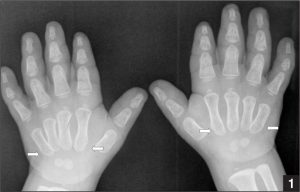Acromicric dysplasia is an extremely rare skeletal condition characterized by short stature, small limbs, stiff joints and facial anomalies. The newborn infants with this condition appear to be normal in size, but the growth rate becomes slow resulting in short stature. Their limbs appear to be disproportionately short for their height. The prognosis of these individuals appears good without any complications. They tend to have a good mental function and can continue a normal life expectancy. The prevalence of this rare disorder is unknown.
Causes
This develops as the result of a mutation in the gene FBN1 which is essential in delivering instruction for the production of a protein known as fibrillin-1. In the extracellular matrix, the molecules of fibrillin-1 attach to one another along with other proteins to create filaments called microfibrils. This provides strength and supports the bones, skin and organs. The microfibrils also store molecules that are essential in controlling the growth and repair of tissues in the body. The genetic mutation of the gene FBN1 alters the protein fibrillin-1 resulting in its disorganization and reduction in numbers causing features of acromicric dysplasia.
Most of the cases of acromicric dysplasia are not inherited and develop as the result of a new mutation in the gene. However, it can be inherited in an autosomal dominant manner where one copy of the defective gene is sufficient to cause this condition.
Symptoms
Acromicric dysplasia may become apparent in the late infancy. The signs of this disorder include abnormally short limbs, short stature reported to be 4 feet in height and mild facial anomalies. Some of the bones of the limbs and digits appear short and stubby. The mild abnormal facial feature includes a round face, long eyelashes, sharply defined eyebrows, thick lips, small mouth, a long space between the nose and the lip. In addition, they can have respiratory infections, spine abnormalities and the movements of the joints affected. The facial features appear less obvious as they become adults.
Diagnosis
The diagnosis is based on the physical examination that identifies features characteristic of this condition. Also, a thorough evaluation of the individual’s medical history is necessary along with a number of laboratory tests to confirm the diagnosis. The x-ray imaging can detect the abnormalities of the limbs and when the cartilage cells are observed under the microscope, the abnormal growth is identified.
Treatment
The treatment for acromicric dysplasia focuses on the specific symptoms associated with this condition. The treatment may also require the coordinated support of different medical specialists such as pediatricians, orthopedists and physical therapists who may determine an appropriate treatment plan for the person. A genetic counseling may be beneficial for some of the affected individuals and their family members.